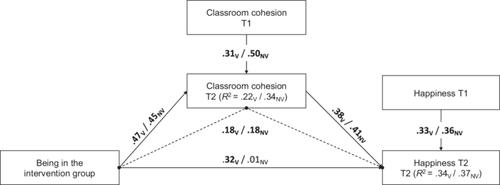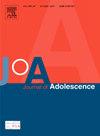Happiness Through HateLess? Examining the Direct and Indirect Effects of an Anti-Hate Speech Program on Victimized and Non-Victimized Youth
Abstract
Introduction
This study investigated how a 1-week anti-hate speech intervention fosters positive classroom dynamics and improves adolescent well-being. Drawing on Social Capital Theory, we examined whether classroom cohesion enhances happiness among victimized and non-victimized students.
Methods
A sample of 820 adolescents aged 12 to 16 (M = 13.27, SD = 1.04) from 11 German schools was divided into an intervention group (n = 567), which participated in the intervention, and a control group (n = 253). Self-report measures of classroom cohesion, happiness, and hate speech victimization were administered before the intervention (T1) and again 1 month later (T2).
Results
Multilevel mediation path analysis revealed that, within the victim subsample, the intervention had a significant direct effect on T2 happiness and mediated effect through classroom cohesion, indicating partial mediation. Conversely, in the non-victim subsample, the effect of the intervention on T2 happiness was fully mediated by classroom cohesion. Hence, the increase in happiness resulting from the intervention can be fully explained by improvements in classroom cohesion. This suggests that, in contrast to non-victims, victimized students derive unique direct benefits from the intervention, in addition to the positive impact of enhanced classroom cohesion.
Conclusions
The study underscores the significance of fostering strong social networks in educational settings as a key to student happiness. These insights point toward the potential benefits of tailored intervention approaches, particularly for students facing challenges related to victimization, and highlight the broader educational value of initiatives that build social capital within classrooms.


 求助内容:
求助内容: 应助结果提醒方式:
应助结果提醒方式:


